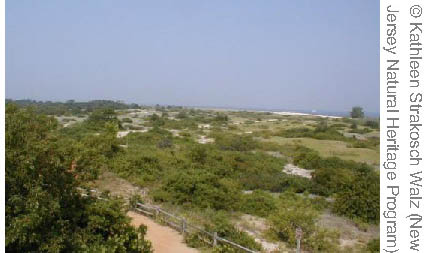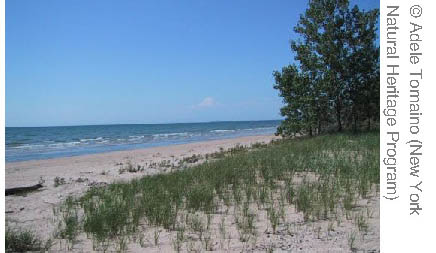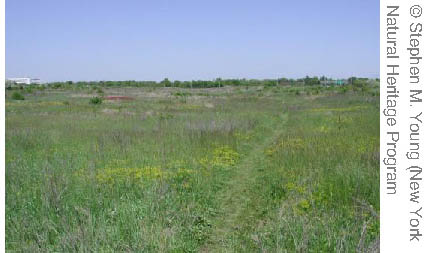The Coastal grassland and shrubland macrogroup consists of the following habitats:
Atlantic Coastal Plain Beach and Dune


Regional distribution:
CT, DE, MA, MD, ME, NH, NJ, NY, RI, VA. 96,690 total acres of habitat, of which 37.5% is conserved.
Description:
A sparsely vegetated beach, dune, or barrier island on unconsolidated sand and shell sediments on the Atlantic coast. A range of plant communities may be present, but trees and shrubs are restricted to sheltered areas. Constantly shifted by winds and floods, the dynamic disturbance regimes largely limit vegetation to pioneering, salt-tolerant, succulent annuals. Sea-rocket and Russian thistle are usually most numerous and characteristic. Areas that are permanently or semipermanently flooded with freshwater support pond or marsh-like vegetation, and are affected by salt spray or overwash during periodic storm events. Both upland and non-flooded wetland vegetation are included in this system and it is broadly defined in terms of floristic composition.
Download the
pdf for this habitat for information about species, crosswalks to state names, and condition of this habitat.
Great Lakes Dune and Swale


Regional distribution:
NY, PA, VT. 1,805 total acres of habitat, of which 62.5% is conserved.
Description:
A sparsely vegetated dune complex on unconsolidated sand and shell sediments on the shores of the Great Lakes. Plant cover varies from sparse on active dunes to moderate depending on the degree of sand deposition, sand erosion, and distance from the lake. Beachgrass dominates the most active areas; on more stable portions, low shrubs including beach heather, juniper, and sand cherry predominate. Backdunes may grade into wooded cover of pines and other sandy soil trees. Jack pine, white pine, and red pine often form a scattered overstory canopy, and juniper and bearberry form a dwarf shrub layer. Wet swales are usually graminoid-dominated, but partly forested swales of red maple, alder, willow, and northern white cedar, may be interspersed with the back-dune ridges.
Download the
pdf for this habitat for information about species, crosswalks to state names, and condition of this habitat.
North Atlantic Coastal Plain Heathland and Grassland


Regional distribution:
CT, MA, NH, NY, RI. 32,837 total acres of habitat, of which 28.8% is conserved.
Description:
A heathland/grassland complex of acidic, nutrient-poor and very well drained soils in coastal areas of southern New England and New York. The vegetation is maintained by extreme conditions and periodic fire or other disturbance. The system has a variable structure and may occur as heathlands, grasslands, or support a patchwork of grass and shrub vegetation. Characteristic species include huckleberry, bearberry, broom crowberry, Nantucket shadbush, golden heather, blueberry, little bluestem, and Pennsylvania sedge. They are important habitat for several bird and other animal species including the short-eared owl and regal fritillary, and (along with brushy plains and woodlands) provided habitat for the extinct heath hen.
Download the
pdf for this habitat for information about species, crosswalks to state names, and condition of this habitat.